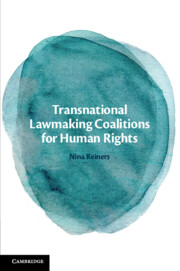Book contents
- Transnational Lawmaking Coalitions for Human Rights
- Transnational Lawmaking Coalitions for Human Rights
- Copyright page
- Dedication
- Contents
- Figures
- Tables
- Acknowledgments
- Abbreviations
- 1 Introduction
- 2 Human Rights Treaty Interpretation
- 3 Transnational Lawmaking Coalitions
- 4 How Water Became a Human Right
- 5 Interpretation across Treaty Bodies
- 6 Lawmaking without Governments?
- 7 Conclusion
- Book part
- Bibliography
- Index
6 - Lawmaking without Governments?
Published online by Cambridge University Press: 25 November 2021
- Transnational Lawmaking Coalitions for Human Rights
- Transnational Lawmaking Coalitions for Human Rights
- Copyright page
- Dedication
- Contents
- Figures
- Tables
- Acknowledgments
- Abbreviations
- 1 Introduction
- 2 Human Rights Treaty Interpretation
- 3 Transnational Lawmaking Coalitions
- 4 How Water Became a Human Right
- 5 Interpretation across Treaty Bodies
- 6 Lawmaking without Governments?
- 7 Conclusion
- Book part
- Bibliography
- Index
Summary
Chapter 6 addresses the absence of the state from the procedures described throughout the book with a forward-looking eye on the TLC and the present status of the human rights regime. On the TLC, this chapter advances the argument such coalitions are in no way to be seen as a mode of international lawmaking without governments, as states, in their status as the treaty body system’s ultimate arbiters, have ample opportunities to mold the system to their liking – by way of, for example, elections, ratifications, budget, willingness to participate in the procedures, and compliance with their obligations. Indeed the Treaty Body Reform 2020 initiative reflects their awareness of autonomy of the treaty bodies themselves. With it likely that states cannot enact this reformation while also maintaining presence in the human rights regime, it will be crucial to see how this conflict plays out in the future.
- Type
- Chapter
- Information
- Transnational Lawmaking Coalitions for Human Rights , pp. 116 - 130Publisher: Cambridge University PressPrint publication year: 2021

